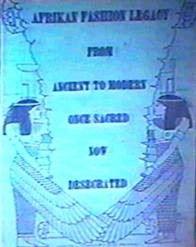 Thousands of years ago, Afrikans left a legacy of fashion, style and beauty preserved on temple walls through their carvings. A brief comparison of the past to the present will be highlighted in an attempt to show that in addition to civilization, the Afrikan also brought fashion and culture to the world.
Thousands of years ago, Afrikans left a legacy of fashion, style and beauty preserved on temple walls through their carvings. A brief comparison of the past to the present will be highlighted in an attempt to show that in addition to civilization, the Afrikan also brought fashion and culture to the world.
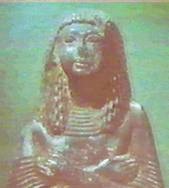 To the Afrikan people, fashion and cloth were regarded as sacred and worthy of the great deities, but it is now being plagiarized, plundered, ridiculed and desecrated.
To the Afrikan people, fashion and cloth were regarded as sacred and worthy of the great deities, but it is now being plagiarized, plundered, ridiculed and desecrated.
It is a known fact that civilization began in Black Afrika where our ancestors dressed the deities according to the powers they possessed. The world’s oldest surviving dress was found in an area of ancient Egypt dating back to about 2,800 B.C.

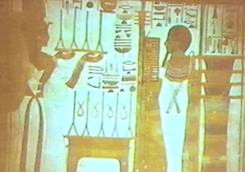 For example, look at the great deity Asa-ru (left image) who is wearing a shroud and seated on his throne as the ruler of the spiritual realm with his wife Ast, Aset (or Isis as transposed by the Greeks).
For example, look at the great deity Asa-ru (left image) who is wearing a shroud and seated on his throne as the ruler of the spiritual realm with his wife Ast, Aset (or Isis as transposed by the Greeks).
In the valley of the queens, Nefertari is shown offering linen cloth to the deity Ptah (right image) who is wearing a shroud signifying that he is in the spiritual realm, and on the shroud is an X which signifies resurrection from the spiritual world.

 On examining some of the ancient garments similar to what is seen on this acrobatic dancer (left) which goes back to the old kingdom about 5,000 years ago, note that she is wearing a loin cloth around her waist which has evolved into the underpants. This can also be seen on this terracotta figure, (right) which dates back to Edfu in Egypt over 3,000 years ago.
On examining some of the ancient garments similar to what is seen on this acrobatic dancer (left) which goes back to the old kingdom about 5,000 years ago, note that she is wearing a loin cloth around her waist which has evolved into the underpants. This can also be seen on this terracotta figure, (right) which dates back to Edfu in Egypt over 3,000 years ago.
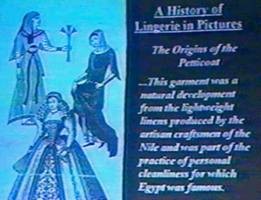
 In the book “20,000 years of fashion”, it is said that English women did not appear to wear drawers until the end of the 18th century, so while Black Afrikans were wearing them over 3,000 years ago, the English did not envision such garments until about 300 years ago, yet praise and honour are given to Europe when it comes to fashion, side stepping the fact that it all originated with the Black people of Afrika.
In the book “20,000 years of fashion”, it is said that English women did not appear to wear drawers until the end of the 18th century, so while Black Afrikans were wearing them over 3,000 years ago, the English did not envision such garments until about 300 years ago, yet praise and honour are given to Europe when it comes to fashion, side stepping the fact that it all originated with the Black people of Afrika.
Looking at the history of the lingerie, the origins of the petticoat can be found as a garment that developed naturally from the fine, lightweight linens produced by the artists and craftsmen who lived in the Nile Valley, which was a part of the practice of personal cleanliness for which Black Egypt was well known.
This is one of the outer garments called the kalasiris, a name given to this tight fitting garment worn by the ancient deities, but modern designers would give you the impression that they were the creators of these styles.
 The kalasiris may be the only garment worn today that looks just as it did in 1,000 B.C., where it quickly evolved after its inception into the well-known tight, body-fitting, chest to ankle-length dress that clings to every curve of a shapely body.
The kalasiris may be the only garment worn today that looks just as it did in 1,000 B.C., where it quickly evolved after its inception into the well-known tight, body-fitting, chest to ankle-length dress that clings to every curve of a shapely body.
The kalasiris was introduced right after the establishment of the New Kingdom in 1,000 B.C. and was a garment for both sexes.
The kalasiris became the standard dress for the ancient Egyptians, where the common fabric was an off-white linen so finely woven, that it appeared as if it were transparent.
MOST EGYPTIAN CROWNS WERE BASED ON THE HAIR STYLES OF AFRIKANS WHICH WERE LATER COPIED BY THE EUROPEAN.

 Look at the mitre worn by the Pope and see how it resembles the white Hedjet crown worn by Menkaure, which symbolized his power in Upper Egypt or Egypt in the South.
Look at the mitre worn by the Pope and see how it resembles the white Hedjet crown worn by Menkaure, which symbolized his power in Upper Egypt or Egypt in the South.
The white crown was worn by the rulers of Upper Egypt before the unification with Lower Egypt, and had a special association with the goddess Nekhbet.
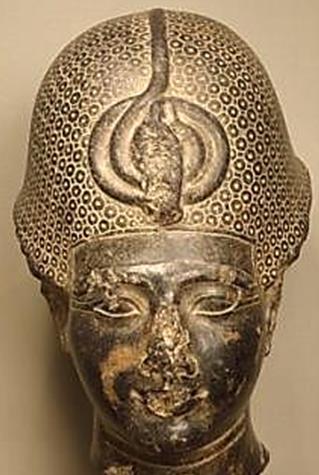
 Here is King Tutankhamen (left) wearing the Khepresh, (the war or ceremonial crown), with its blue and gold colours symbolizing his power over the skies. In addition, he also has the protective deity, the Wadjet or (Udjat) cobra - the eye of Horus, which symbolizes healing and protection, indicating that he would strike out at his enemies. This crown was copied by Aleister Crowley (right), an occultist and magician who founded a sexually oriented cult, where he indulged in every form of sexual perversion imaginable. One of his main activities was to transmit hate vibrations in the 1960’s with the aim of starting a race riot, so while King Tut used his crown to wage war on his enemies, Aleister Crowley used his to wage war against innocent Black people.
Here is King Tutankhamen (left) wearing the Khepresh, (the war or ceremonial crown), with its blue and gold colours symbolizing his power over the skies. In addition, he also has the protective deity, the Wadjet or (Udjat) cobra - the eye of Horus, which symbolizes healing and protection, indicating that he would strike out at his enemies. This crown was copied by Aleister Crowley (right), an occultist and magician who founded a sexually oriented cult, where he indulged in every form of sexual perversion imaginable. One of his main activities was to transmit hate vibrations in the 1960’s with the aim of starting a race riot, so while King Tut used his crown to wage war on his enemies, Aleister Crowley used his to wage war against innocent Black people.

 Note that the Catholic Pope (right) is also wearing a similarly constructed head piece, as the vatican got their concepts mainly from East and West Afrika. This represents the head dress from which both the mitre and the Papal tiara originate.
Note that the Catholic Pope (right) is also wearing a similarly constructed head piece, as the vatican got their concepts mainly from East and West Afrika. This represents the head dress from which both the mitre and the Papal tiara originate.
By 1150 its popularity and use had spread to the bishops throughout the West, and by the 14th century the tiara was decorated with three crowns.
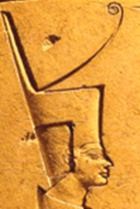
 The Black ancestors also wore a variety of head pieces and crowns like this Deshret worn by King Djoser, dating back to the 3rd dynastic period 4,000 years ago. The red crown symbolized his power in Lower Egypt or Egypt in the North.
The Black ancestors also wore a variety of head pieces and crowns like this Deshret worn by King Djoser, dating back to the 3rd dynastic period 4,000 years ago. The red crown symbolized his power in Lower Egypt or Egypt in the North.
This hat was later copied and worn by a religious group of men from Venice and Genoa in the 1400’s called the Doge.
Notice that the hat worn by the Doge very closely resembles the head piece worn by King Djoser.

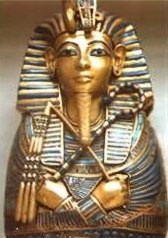 Note the similarities between the wigs that are worn by the judges and officials of England and see how closely they resemble the Nemes of the gold and blue mask of King Tutankhamen which signifies his dominion over the skies.
Note the similarities between the wigs that are worn by the judges and officials of England and see how closely they resemble the Nemes of the gold and blue mask of King Tutankhamen which signifies his dominion over the skies.
He also wears the protective deity of Wadjet and Nekhbet - Protectress of Upper Egypt.
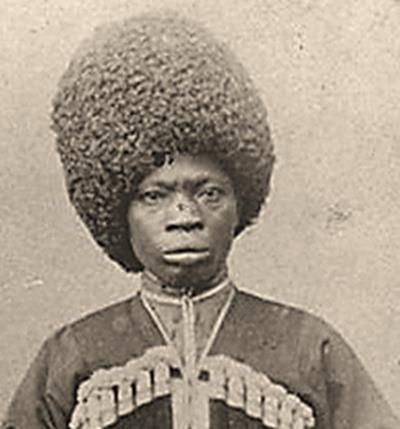
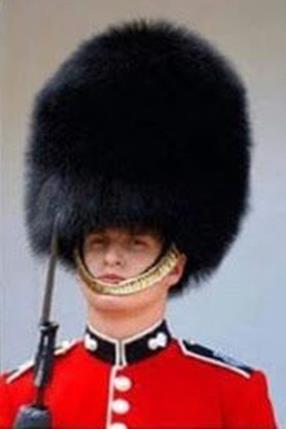
This is an indigenous native Abkhazian tribesman circa 1870, the original people of Russia. This is his real hair. The British guards wear this impressive, inspiring, copied hair style as a hat.
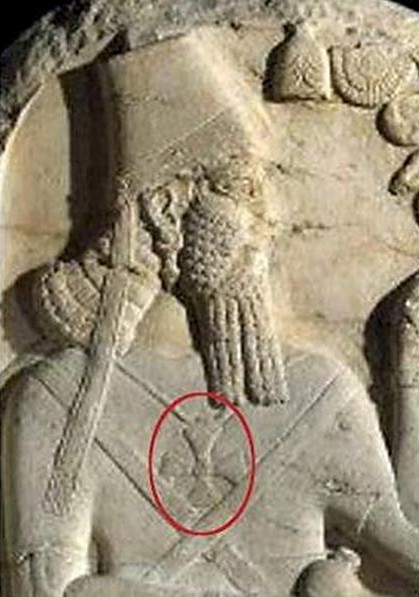
 Here the Pope is wearing a cross similar to the one worn on the chest of this ancient Assyrian king. 800 years before Christ was born, this cross was identified with a native Mesopotamian deity and a Sun god named Shamash, the god of justice in the Akkadian, Assyrian and Babylonian deities.
Here the Pope is wearing a cross similar to the one worn on the chest of this ancient Assyrian king. 800 years before Christ was born, this cross was identified with a native Mesopotamian deity and a Sun god named Shamash, the god of justice in the Akkadian, Assyrian and Babylonian deities.
It is also called the Maltese cross by the Knights of Malta, and the Iron Cross, which was revived by Adolph Hitler in 1939 with a Nazi swastika imprinted in the middle.
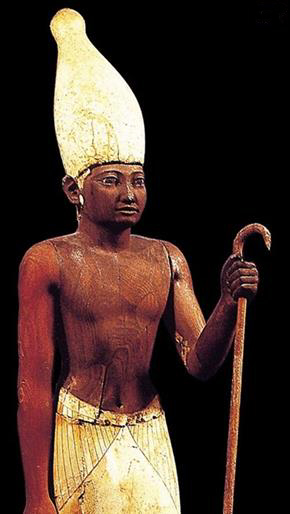
 This staff held in the hand is known as the Shepherd's crook, (or the crosier, pastoral or bishop's staff) which is carried by the bishop or other high-ranking ecclesiastical dignitaries.
This staff held in the hand is known as the Shepherd's crook, (or the crosier, pastoral or bishop's staff) which is carried by the bishop or other high-ranking ecclesiastical dignitaries.
It depicts the many symbolic representations to bishops as the shepherds of their Christian flock, emulating the analogy of Christ as the Good Shepherd. The Shepherd's crook is a part of the custom of Jewish Christianity.

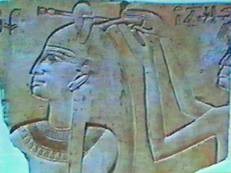 In the book “20,000 years of fashion”, it is stated that the hair worn by the Egyptians was parted into plaits and locks according to the ancient Afrikan custom of over 40,000 years. In order to be elegant, it was essential to take care of one’s hair, so our Black ancestors were extremely particular in terms of the selective hair styles they wore.
This is Queen Nefru (on the right) getting her locks palm rolled by her hair stylists.
In the book “20,000 years of fashion”, it is stated that the hair worn by the Egyptians was parted into plaits and locks according to the ancient Afrikan custom of over 40,000 years. In order to be elegant, it was essential to take care of one’s hair, so our Black ancestors were extremely particular in terms of the selective hair styles they wore.
This is Queen Nefru (on the right) getting her locks palm rolled by her hair stylists.
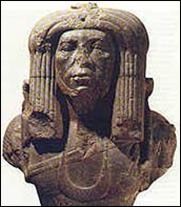 Styling the hair in locks was therefore an ancient fashion as can be seen on Amememhet III who is characterized wearing “dread locks" which can be traced back to about 4,000 years ago.
Styling the hair in locks was therefore an ancient fashion as can be seen on Amememhet III who is characterized wearing “dread locks" which can be traced back to about 4,000 years ago.
 Our Black ancestors were very meticulous in making sure that they not only created beautiful pieces of cloth and clothing, but they also made sure that their bodies were also kept clean.
Our Black ancestors were very meticulous in making sure that they not only created beautiful pieces of cloth and clothing, but they also made sure that their bodies were also kept clean.
But if you were to visit medieval Europe, one would realize that this was not the case where keeping a clean body and garments were important.
 A book written by a European named Terence McLaughlin entitled “Dirt; a Social History as seen through the Uses and Abuses of Dirt”, described that practice while speaking about his European ancestors.
A book written by a European named Terence McLaughlin entitled “Dirt; a Social History as seen through the Uses and Abuses of Dirt”, described that practice while speaking about his European ancestors.
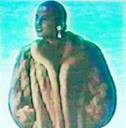 Similar information can also be found in a book called “A History of Costumes” by Rachel Cooper, which gives the origin of many of the European fashions like the glorified fur coat. This was originally designed to keep flees off the body and not for the warmth it provides, much less the beauty for which it is presently worn.
Similar information can also be found in a book called “A History of Costumes” by Rachel Cooper, which gives the origin of many of the European fashions like the glorified fur coat. This was originally designed to keep flees off the body and not for the warmth it provides, much less the beauty for which it is presently worn.
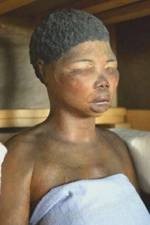
 This is Ssehura, renamed Saartjie (Sarah) Baartman, a young Khoisan girl who was orphaned in the 1700’s in South Afrika, also known as the "Hottentots Venus" because of her pronounced buttocks and genitalia. In 1810 when 19 years old, she was kidnapped from South Afrika to be exhibited naked in a travelling freak show like a wild beast in Europe during 19th century, after William Dunlop, a ship's doctor, told her that she could earn a fortune in Europe, but instead she became a freak-show attraction and was continuously inspected by fake scientists and often put under the prying eye of the general public. White people were captivated at seeing the genitalia of a Black woman. At age 25 Sarah passed away because of the many cruel experiments that were done on her body in the name of science.
This is Ssehura, renamed Saartjie (Sarah) Baartman, a young Khoisan girl who was orphaned in the 1700’s in South Afrika, also known as the "Hottentots Venus" because of her pronounced buttocks and genitalia. In 1810 when 19 years old, she was kidnapped from South Afrika to be exhibited naked in a travelling freak show like a wild beast in Europe during 19th century, after William Dunlop, a ship's doctor, told her that she could earn a fortune in Europe, but instead she became a freak-show attraction and was continuously inspected by fake scientists and often put under the prying eye of the general public. White people were captivated at seeing the genitalia of a Black woman. At age 25 Sarah passed away because of the many cruel experiments that were done on her body in the name of science.
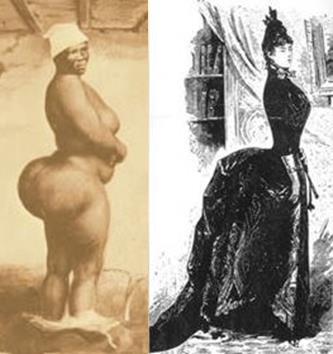
 For several years, working-class Londoners crowded around to shout vulgarities at the protruding buttocks of this unfortunate woman, but in secret, her contours were most admired and desired by the countrymen, so European women began imitating this shape by designing and wearing a large pad around their waist to mimic Sarah’s protruding curves, and from this practice The Bustle was developed which set a major fashion trend into motion.
For several years, working-class Londoners crowded around to shout vulgarities at the protruding buttocks of this unfortunate woman, but in secret, her contours were most admired and desired by the countrymen, so European women began imitating this shape by designing and wearing a large pad around their waist to mimic Sarah’s protruding curves, and from this practice The Bustle was developed which set a major fashion trend into motion.
When Sarah died, her buttocks were put on display in a museum in France until as recently as 1985. She became an icon for South Afrikan women who continue to suffer abuse and exploitation.

 Kente Cloth is the best known of all Afrikan textiles which is made of silk fibres woven on horizontal treadle looms by the Asante people of Ghana (right). It is identified by its dazzling, multi-coloured patterns of bright colours, geometric shapes and bold designs. Traditionally, Kente was the cloth of royalty, the rich, Kings, and Queens who controlled the use and production of Kente for their household, officials or political allies. Today, as more people developed an interest in Afrikan fashions, the Kente cloth became well-known, and this caused the Asante in Ghana to become very concerned about the treatment of this cloth, because to them it is very sacred, so they believe that with the imitations and increased production of this cloth, some form of desecration would become inevitable.
Kente Cloth is the best known of all Afrikan textiles which is made of silk fibres woven on horizontal treadle looms by the Asante people of Ghana (right). It is identified by its dazzling, multi-coloured patterns of bright colours, geometric shapes and bold designs. Traditionally, Kente was the cloth of royalty, the rich, Kings, and Queens who controlled the use and production of Kente for their household, officials or political allies. Today, as more people developed an interest in Afrikan fashions, the Kente cloth became well-known, and this caused the Asante in Ghana to become very concerned about the treatment of this cloth, because to them it is very sacred, so they believe that with the imitations and increased production of this cloth, some form of desecration would become inevitable.
Kente is considered to be more important than just being a cloth in a total cultural context, as it is a visual symbol of the history, philosophy, ethics, oral literature, moral values, religious beliefs, political thought, and social code of conduct.
Kente can be compared to an evening gown or tuxedo in Western cultures, and when worn or used on ceremonial occasions, it brings honour and prestige to the proceedings.
 Currently the Kente cloth is found all over the world but increasingly in very negative forms as seen in this Mickey and Minnie Mouse picture, where they are dressed in this sacred icon.
Currently the Kente cloth is found all over the world but increasingly in very negative forms as seen in this Mickey and Minnie Mouse picture, where they are dressed in this sacred icon.
This shows that the weavers of the Kente cloth were justified in their concerns, because the popularity and lack of knowledge about this very important and sacred cloth has led to its defamation.


© John Moore - Barbados, W.I. (March 2000) ©. All rights reserved.